Vietnam beckons with a captivating blend of breathtaking landscapes, ancient traditions, vibrant cities, and an incredible culinary scene. Deciding where to go can be overwhelming, given the wealth of experiences on offer. From mist-shrouded mountains and lush deltas to historic sites whispering tales of empires and conflicts, Vietnam promises a journey for every type of traveler. To help you navigate this fascinating country, here are the 15 Best Things To See In Vietnam, offering a glimpse into its soul.
See the Rich Flavors of Imperial Hue
Vietnam’s last imperial dynasty, the Nguyen, reigned in Hue until 1945. While its historic structures bear the scars of time, they still stand as impressive reminders of a bygone era, hinting at connections closer to imperial China than other parts of Southeast Asia. For many visitors, however, the true spectacle in Hue lies in its culinary heritage. It’s said that over half of Vietnam’s estimated 3000 local dishes originated here.
From the spicy vermicelli noodle soup bun bo Hue and crispy banh khoai pancakes topped with shrimp and pork, to delicate, layered banh it ram dumplings, the variety is astounding. You can even experience the lavish am thuc cung dinh, the imperial cuisine perfected by the emperors’ chefs, at some of Hue’s esteemed restaurants. But don’t miss the chance to taste authentic, budget-friendly Hue staples from bustling street stalls and local eateries – it’s a feast for the senses.
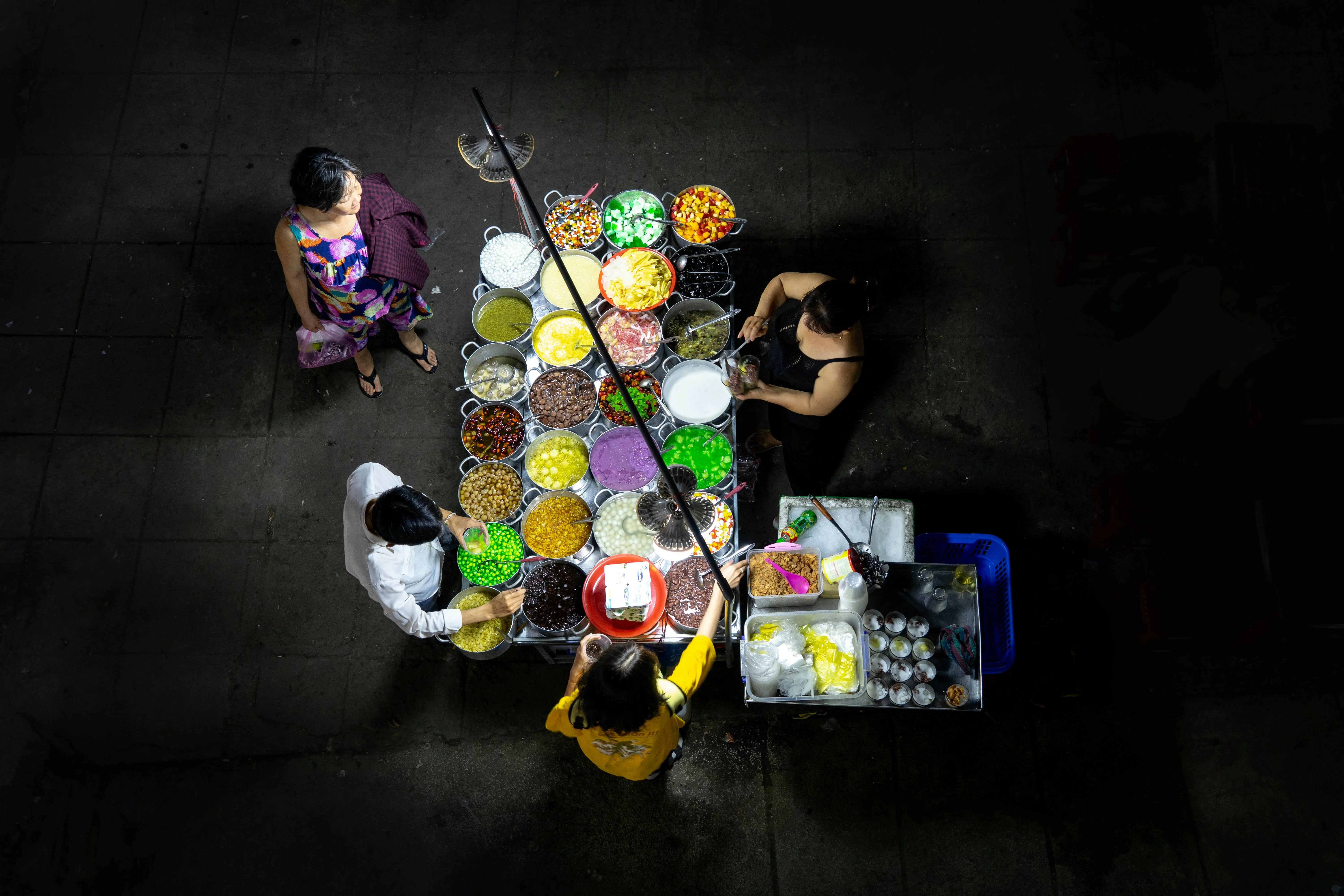 An aerial view of a street vendor selling food at night, with colorful ingredients in containers brightly lit. Three customers are visible at the stand.
An aerial view of a street vendor selling food at night, with colorful ingredients in containers brightly lit. Three customers are visible at the stand.
Learn to Create Vietnamese Culinary Masterpieces
Imagine bringing the taste of Vietnam back home! Learning to prepare classic Vietnamese dishes is a souvenir that keeps on giving. The delicate balance of flavors, fresh herbs, and vibrant ingredients makes Vietnamese cuisine a favorite for dinner parties and personal enjoyment.
Across the country, numerous cooking classes invite you to dive into the culinary arts. Typically, these experiences begin with a visit to a local market to select fresh produce and aromatic herbs, culminating in a delicious banquet of the dishes you’ve prepared. From mastering the art of rolling fresh summer rolls to perfecting a steaming bowl of pho, these classes offer hands-on insight into the heart of Vietnamese culture through its food. Hoi An is particularly renowned for its cooking schools, but you’ll find excellent options in Hue, Hanoi, and Ho Chi Minh City as well.
Witness Imperial Grandeur at Hue’s Royal Tombs
Hue earns a second mention for its magnificent imperial tombs, the final resting places of several Nguyen emperors and empresses. These elaborate mausoleums offer a poignant connection to Vietnam’s imperial past, stretching from the founder Gia Long to Khai Dinh, the last emperor buried on Vietnamese soil.
While the central Citadel and Imperial Enclosure attract large crowds, the tombs scattered along the Perfume River offer moments of peaceful contemplation. Renting a motorbike provides the freedom to explore these extravagant sites at your own pace, away from organized tours. While exploring the historical landscapes surrounding Hue, be sure not to overlook the towering Thien Mu pagoda. It stands sentinel over the north bank of the river on the city’s edge, offering both spiritual peace and scenic views.
What to Eat in Fort Worth – A Culinary Deep Dive
Discover the Top Restaurants in Denver – A Culinary Journey
Discover Where to Visit in Las Vegas
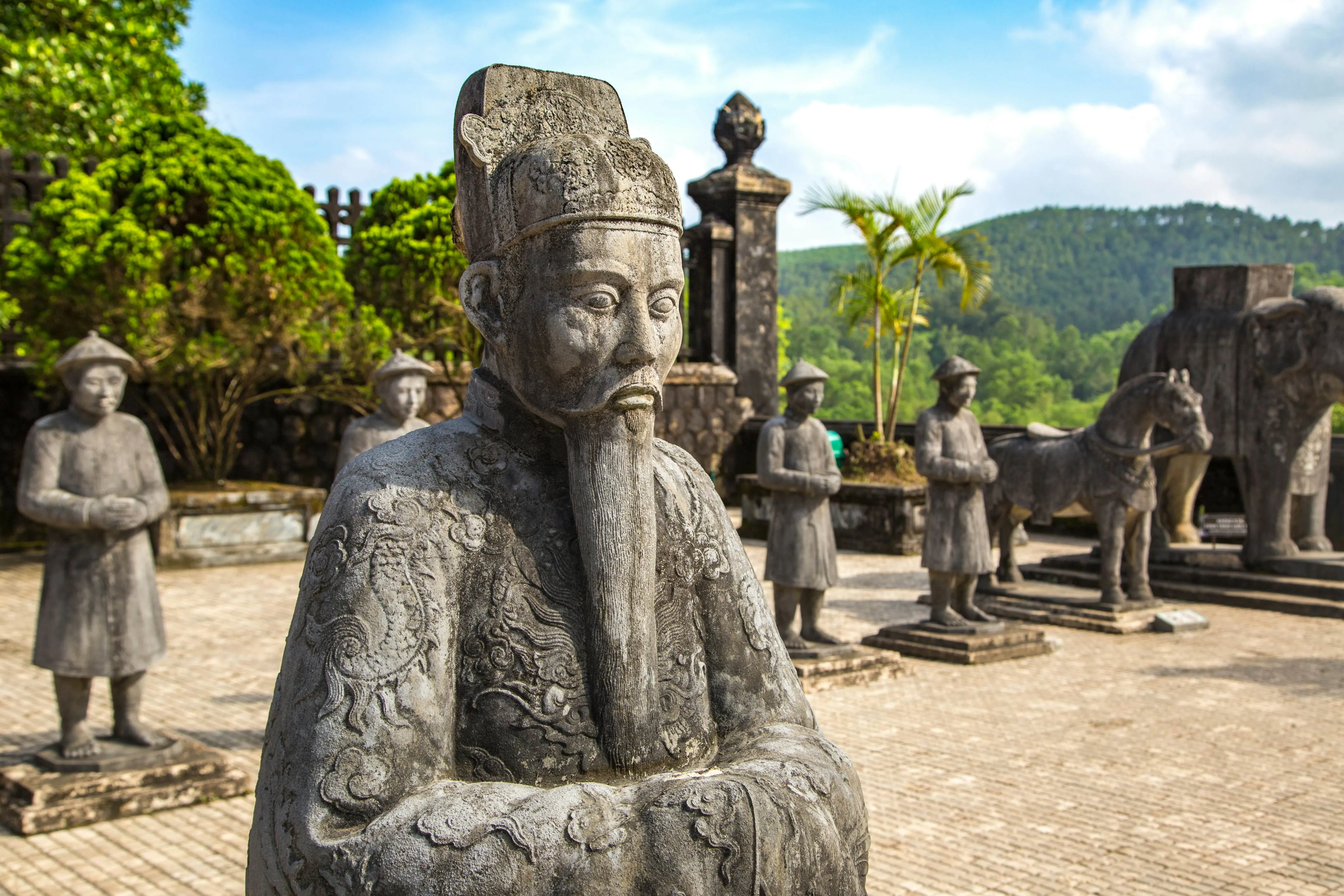 Live-size figurative sculptures depict emperors, members of their court, horses and elephants, displayed in formation in an outdoor plaza at Hue, Vietnam.
Live-size figurative sculptures depict emperors, members of their court, horses and elephants, displayed in formation in an outdoor plaza at Hue, Vietnam.
Explore the Unique Architecture of the Cao Dai Holy See in Tay Ninh
Discover one of the world’s youngest yet most fascinating religions by visiting the Cao Dai Holy See in Tay Ninh. Founded in 1926 in this southern town, Cao Dai seamlessly blends tenets and iconography from diverse traditions, including ancestor worship, folk religions, Confucianism, Taoism, Buddhism, and Roman Catholicism.
The architectural style of the cathedral-like Holy See is a spectacle in itself, reflecting this unique fusion. Inside, the vibrant decor includes striking imagery such as weapon-toting statues, the all-seeing eye (a central symbol), and even elements resembling a Communist red star. The faith honors a wide array of figures, from Jesus Christ and Buddha to Muhammad and even the French novelist Victor Hugo, illustrating its syncretic nature. Visitors are welcome to witness the daily prayer services, a truly unique cultural thing to see in Vietnam.
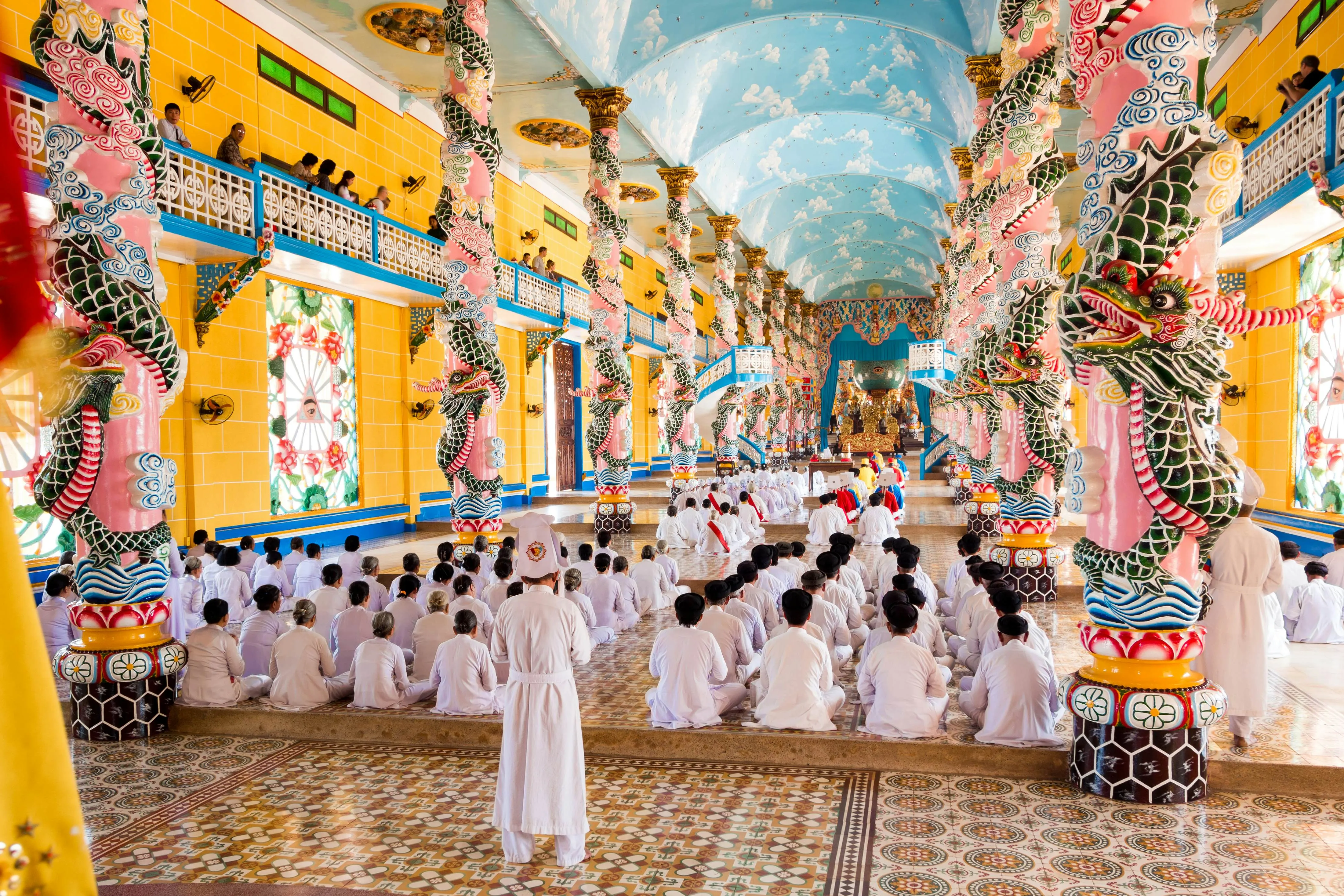 Participants in white robes sit in prayer in a sanctuary during a religious ritual. The sanctuary is painted yellow, with carved, painted dragons and other colorful details.
Participants in white robes sit in prayer in a sanctuary during a religious ritual. The sanctuary is painted yellow, with carved, painted dragons and other colorful details.
Find Serenity in Halong Bay and Bai Tu Long Bay’s Karst Landscape
While Halong Bay’s stunning seascape of eroded karst islands is undeniably popular, it’s still a must-see. Its atmospheric rocky coves and dramatic islets rising from the emerald waters are breathtaking. However, you can escape the busiest routes. Consider exploring nearby Lan Ha Bay near Cat Ba Island by kayak, allowing you to paddle close to outcrops that emerge from the water like mythical sea creatures.
For an even quieter experience, venture further north to the calmer waters of Bai Tu Long Bay. This area features similarly jungle-capped islands, sheltering secluded beaches and tranquil resorts. It offers the same geological wonder as Halong Bay but with a greater sense of peace and discovery, allowing you to find your own island slice of paradise.
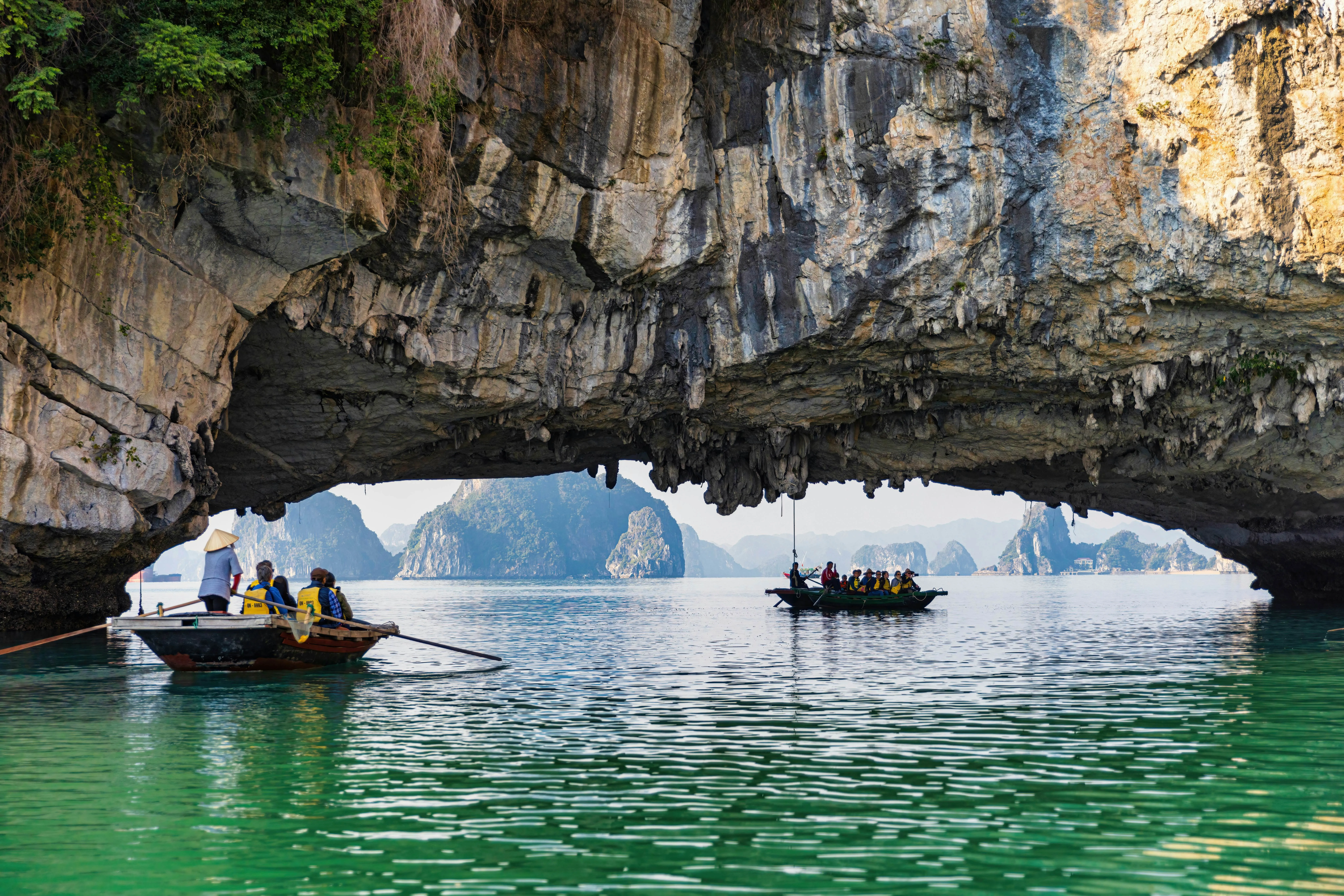 Two boats pass under an archway formed by rocks in a tropical bay with beautiful green water. Karst formations are visible in the distance, through the arch.
Two boats pass under an archway formed by rocks in a tropical bay with beautiful green water. Karst formations are visible in the distance, through the arch.
Uncover Ancient History at the My Son Sanctuary
Step back in time at My Son, a serene historical site that offers a less crowded alternative to Hoi An’s bustling streets, particularly if visited in the afternoon. This UNESCO-listed sanctuary features a collection of atmospheric Hindu temple ruins nestled within a jungle setting, beside a loop of the sacred Thu Bon River.
Built between the 4th and 14th centuries CE by the Hindu kingdom of Champa, these crumbling red-brick shrines share architectural similarities with the famous Khmer temples found in Cambodia and Thailand. The descendants of the Cham people, who built this impressive complex, still inhabit parts of central Vietnam today. Surrounded mainly by the sounds of birdsong, the site provides a powerful sense of history and atmosphere, making it a compelling thing to see in Vietnam. If using Hoi An as your base, consider a detour to the nearby Cham Islands, a marine reserve also home to Cham communities.
 A woman in a straw hat approaches a temple ruin surrounded by jungle.
A woman in a straw hat approaches a temple ruin surrounded by jungle.
Experience the Highlands by Motorbike
Vietnam’s heart often beats on two wheels, and a motorbike trip is an unparalleled way to immerse yourself in the stunning scenery of the northwestern hill country. While it requires courage to navigate the winding roads, unpredictable traffic, and occasional livestock, the freedom it offers is unmatched. Rent a quality bike in Hanoi, then consider putting it on a train to Lao Cai to bypass the potentially nerve-wracking ride out of the capital.
Once you reach the highlands, you can explore remote villages far from typical tourist paths, enjoying epic vistas around every turn. Nights spent in charming homestays hosted by members of Vietnam’s ethnic minority communities offer a unique cultural insight. Experiencing these landscapes by motorbike is one of the most authentic and thrilling ways to see Vietnam’s stunning terrain.
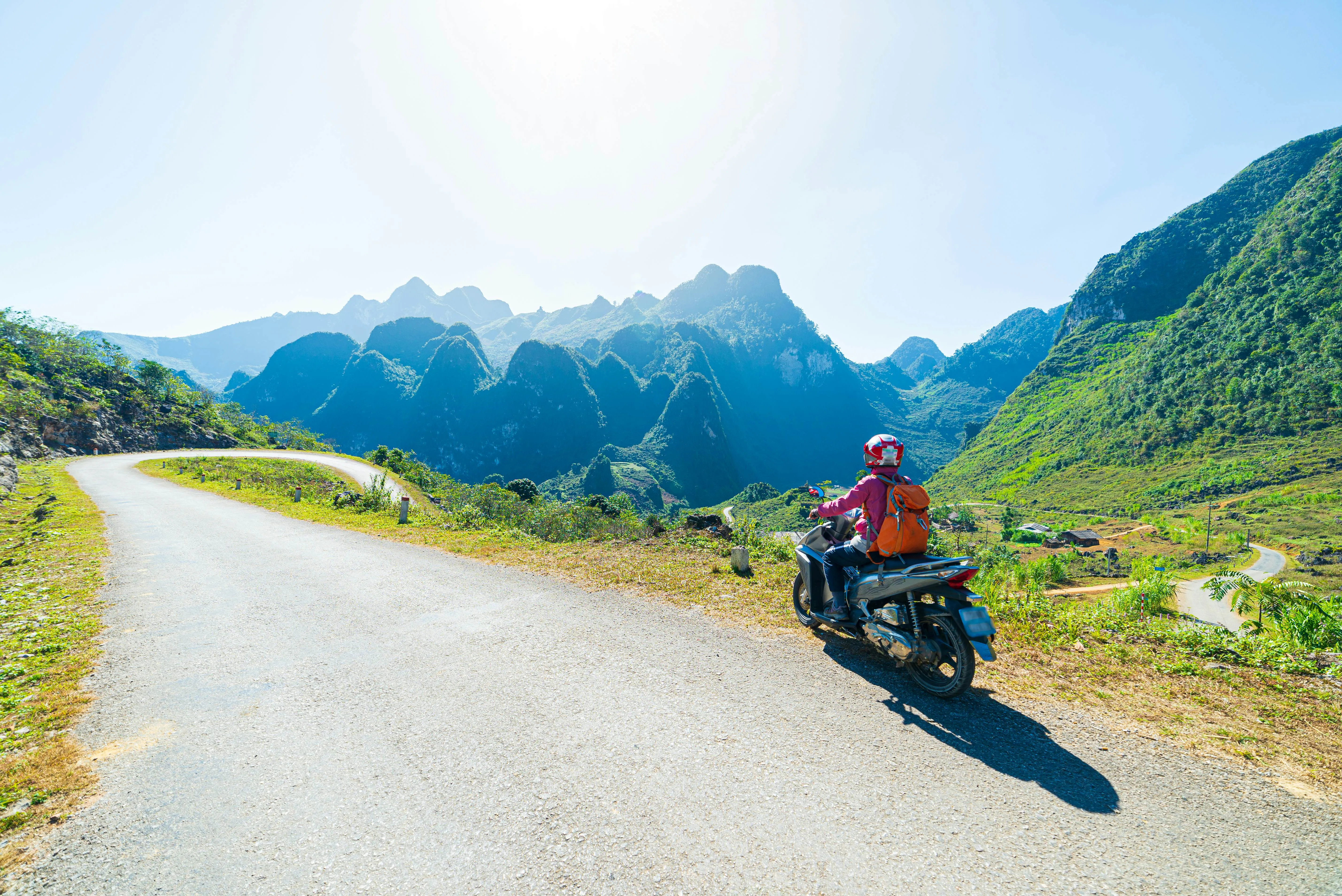 A man on a motor scooter rides on windy mountain road. Hazy green hills are visible in the distance.
A man on a motor scooter rides on windy mountain road. Hazy green hills are visible in the distance.
Visit Traditional Villages in the “Asian Alps”
Sapa, a former French hill station, is renowned for the surrounding mountains that reminded French colonizers of the Alps. The villages of the Hmong and Dzao ethnic minorities nearby have become popular trekking destinations, albeit somewhat commercialized.
For a taste of the serene beauty that first captivated travelers, head to quieter Bac Ha or explore the trails and mountain roads near Ha Giang province. Tucked against the border with China, this region boasts landscapes that appear sculpted by divine hands. Staying in welcoming homestays and visiting local markets, peaceful stilt-house villages, French-era relics, and towering limestone pinnacles offers a profound cultural and scenic experience away from the crowds. The lookouts over the Dong Van Karst Plateau, a UNESCO Geopark, offer some of the strongest contenders for the title of the best vista in Vietnam.
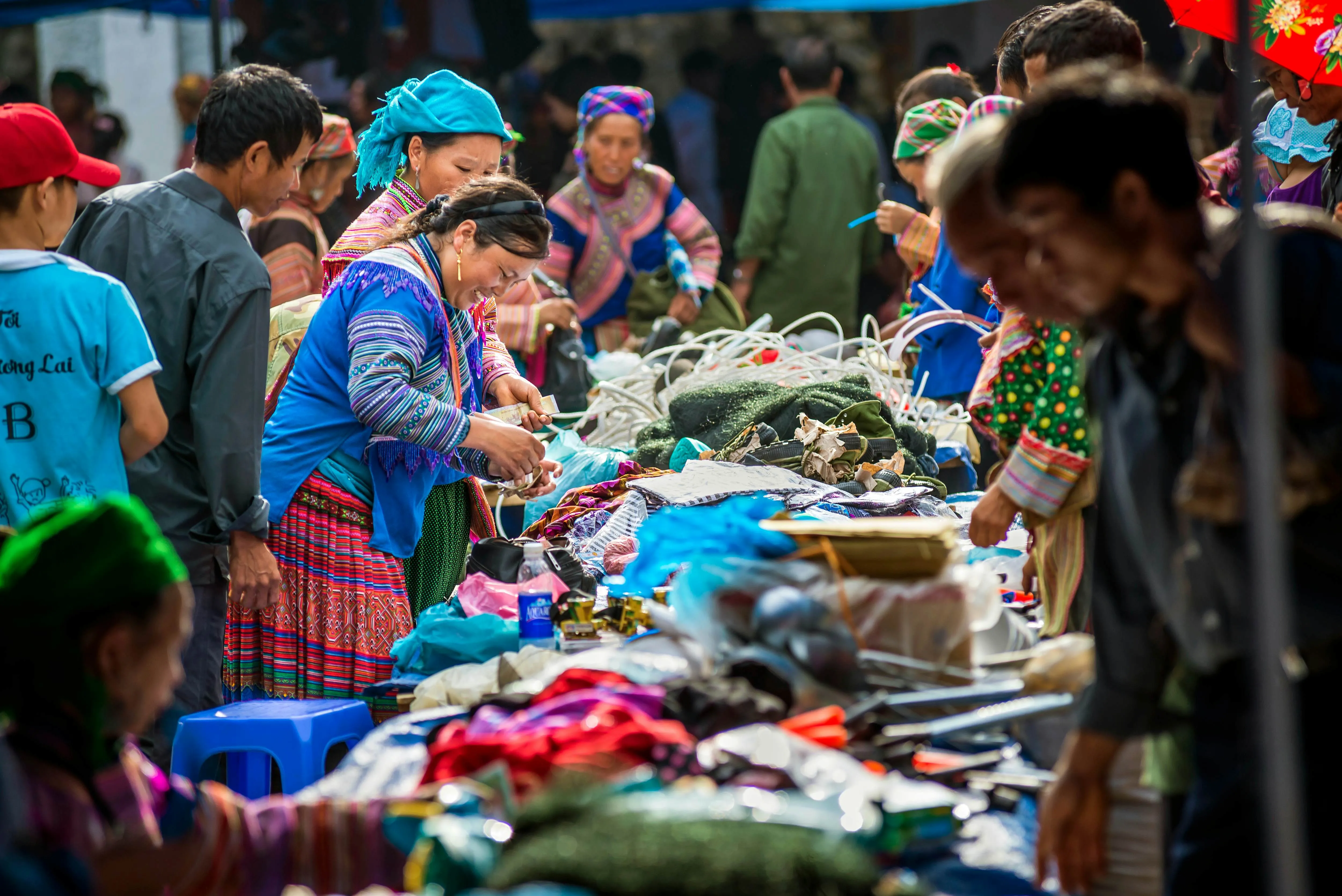 People in colorful, traditional outfits trade dry goods around a table at an outdoor market.
People in colorful, traditional outfits trade dry goods around a table at an outdoor market.
Sip World-Class Coffee in the Central Highlands
Coffee cultivation was introduced to Vietnam by French colonizers, but it was the farmers of the Central Highlands who truly mastered the art of producing quality beans. Dak Lak province, with elevations reaching 1600m, provides ideal conditions for growing robusta beans. Buon Ma Thuot, the regional capital, is the perfect place to tour coffee plantations and savor a perfect cup of caphe. This is particularly true during the annual coffee festival held in March, where the aroma of roasting beans fills the air.
If you prefer arabica, head to Dalat and visit community cooperatives like K’Ho Coffee to support local growers from the K’Ho minority group. The best time to witness the coffee production process is from September to December, during the harvest season, when plantations are vibrant with red beans. This is a unique cultural and agricultural sight among the many things to see in Vietnam.
Explore the Depths of the World’s Largest Cave in Phong Nha
Phong Nha-Ke Bang National Park in north-central Vietnam is a truly extraordinary place, a ‘lost world’ characterized by dense jungles and colossal caverns. Within this park lies Hang Son Doong, recognized as the largest cave in the world. Its sheer scale is almost unimaginable; a 747 airplane could comfortably fly through its main tunnel.
Parts of the cave’s limestone ceiling have collapsed, allowing natural sunlight to penetrate, which has resulted in the formation of an entire rainforest ecosystem within the cave. This unique environment is home to flying foxes, rare langurs, and even a small tiger population. Since 2012, Oxalis Adventure has been the only company permitted to take a very limited number of visitors on challenging four-day treks into Hang Son Doong. While the price reflects the exclusivity and difficulty, the scenery inside is absolutely stratospheric and unlike anywhere else on Earth. This is arguably one of the most spectacular things to see in Vietnam, requiring significant effort but offering unparalleled rewards.
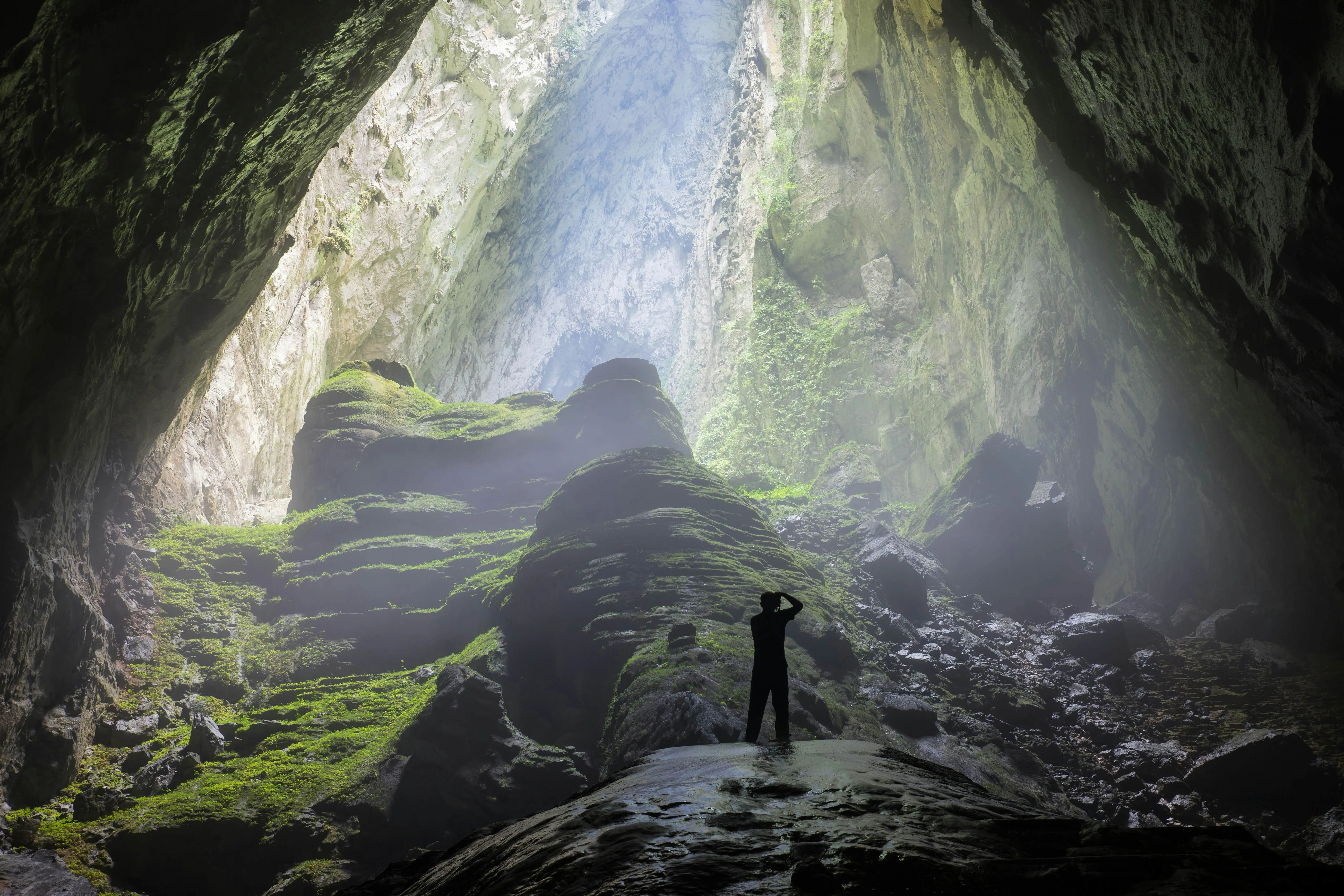 Man at the cave entrance in Son Doong Cave, the largest cave in the world in UNESCO World Heritage Site Phong Nha-Ke Bang National Park.
Man at the cave entrance in Son Doong Cave, the largest cave in the world in UNESCO World Heritage Site Phong Nha-Ke Bang National Park.
Relax or Play on Vietnam’s Beautiful Beaches
Vietnam’s stunning coastline and islands were first highlighted for seaside getaways by the beaches of Phu Quoc Island and Danang. Both have evolved into lively resort destinations, popular with international and domestic tourists alike.
However, if you’re seeking unspoiled stretches of sand, modern-day adventurers can find quieter spots. Explore the kitesurfing beaches around Mui Ne, the pristine island sands of the Con Dao archipelago, or the long, tranquil Hong Van Beach on Co To Island in Bai Tu Long Bay. The best time to enjoy Vietnam’s beaches varies regionally, so check the weather patterns for your chosen destination before you go. Central Vietnam is best from January to August, the south coast from December to April, and northern beaches see dry days from October to April. Finding your perfect sandy spot is a highlight of any trip, offering plenty of relaxing and active things to see in Vietnam.
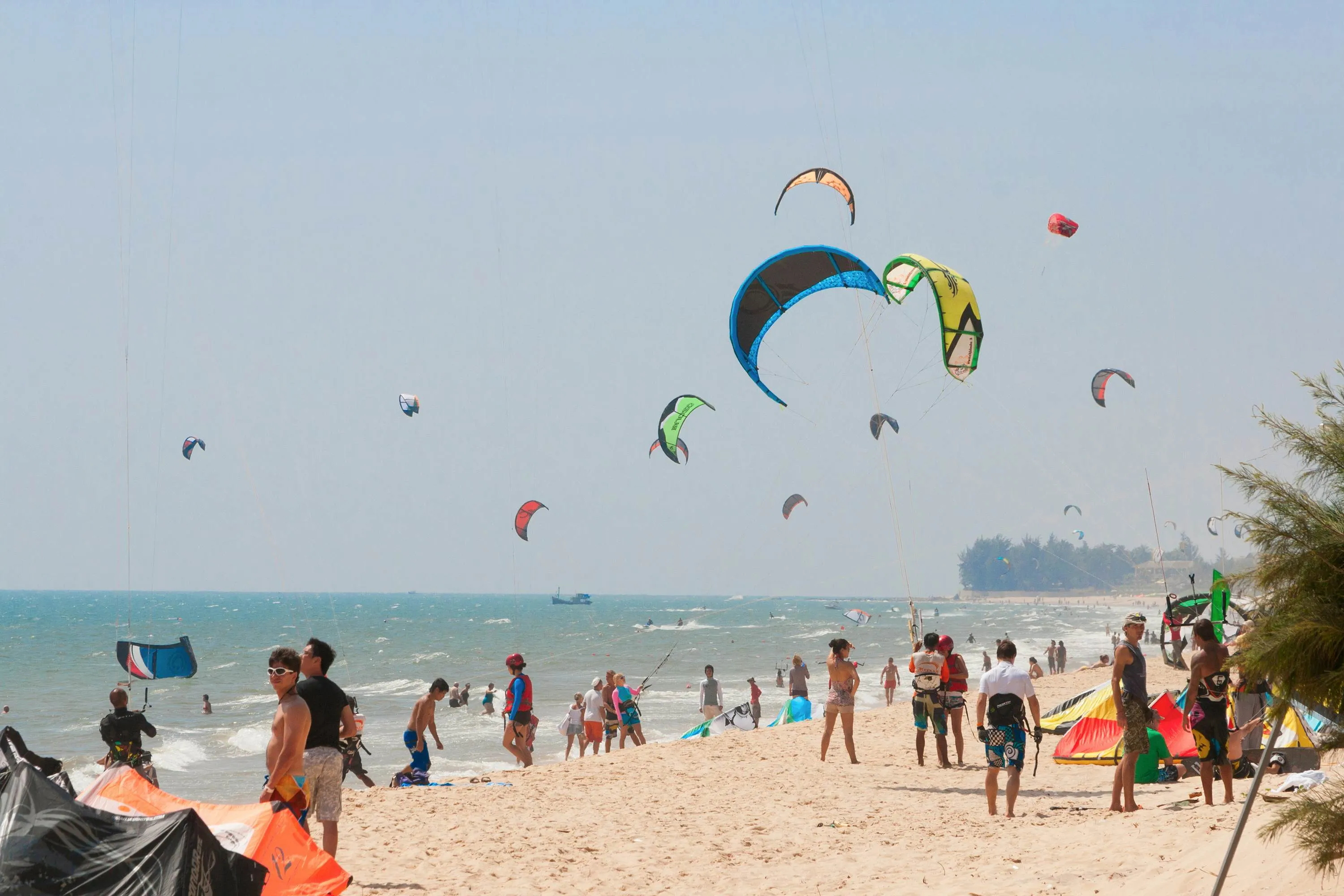 People stand on a beach watching kitesurfers in the sky. Whitecaps are visible on the waves off the coast.
People stand on a beach watching kitesurfers in the sky. Whitecaps are visible on the waves off the coast.
Reflect on History at American War Sites
While modern Vietnam looks firmly towards the future, the battlefields and historical sites from the American War serve as powerful, sobering reminders of the sacrifices made to reach this point. Sites infamous for American losses, like Hamburger Hill in the Demilitarized Zone (DMZ), are etched into global consciousness.
However, to truly understand the Vietnamese experience, visit the wartime tunnels. The Cu Chi tunnels near Ho Chi Minh City and the Vinh Moc tunnels near Hue offer incredible insight into how ordinary people employed ingenious methods and endured unimaginable hardship to resist a global superpower. Walking through these narrow passages provides a visceral connection to the past, highlighting the resilience and determination of the Vietnamese people. These sites are difficult, but important, things to see in Vietnam.
Float Through the Lush Mekong Delta
Reaching out into the East Sea like a vast, verdant hand, the mighty Mekong Delta marks the culmination of Southeast Asia’s longest river. Rising on the Tibetan plateau, this 4350km (2700-mile) monster nurtures a waterlogged wonderland often referred to as Vietnam’s ‘rice bowl’. The delta is a network of sleepy towns, stilt villages, and countless waterways where life and trade primarily revolve around the river.
Booking an overnight cruise along the main channels near Can Tho or a cross-border trip towards Siem Reap in Cambodia offers a comfortable way to see the delta’s beauty. For a more intimate experience, take a day trip into the smaller backwaters near Ben Tre, perhaps arranging a journey with local boat owners in one of the delta villages. Seeing the daily life unfold on the water, the floating markets, and the lush green landscapes is a quintessential thing to see in Vietnam.
 A man steers a wooden boat through a channel in a dense mangrove forest. Aquatic plants are seen on the surface of the water.
A man steers a wooden boat through a channel in a dense mangrove forest. Aquatic plants are seen on the surface of the water.
Walk with Ghosts of French Indochina in Ho Chi Minh City
Ho Chi Minh City, formerly Saigon, is a dynamic metropolis where the past constantly intersects with the present. While the name has changed, the echoes of history are palpable. Relics from the American War are preserved in museums like the HCMC Museum and the poignant War Remnants Museum. Alongside these reminders of conflict stand elegant French-built mansions and civic buildings, repurposed over time to house museums, restaurants, and hotels.
To soak in the vintage atmosphere of HCMC, find a spot at the elegant Hotel Continental Saigon for a traditional caphe sua (milk coffee) or indulge in exquisite French cuisine at a high-end restaurant like La Villa. Then, take a leisurely stroll past architectural gems such as the Central Post Office, Notre Dame Cathedral, and the People’s Committee Building (originally Saigon’s Hôtel de Ville), marveling at the colonial-era grandeur that remains. For a deeper dive into the city’s vibrant street food scene, consider joining a food-focused scooter tour, experiencing the diverse flavors that make HCMC a culinary hotspot. Exploring these historical layers provides fascinating things to see in Vietnam.
Embrace Past and Future in Historic Hanoi
Hanoi, the vibrant capital, serves as a fascinating confluence of old and new Vietnam. As the city surges skyward, traces of its imperial past and wartime resilience float like ghosts through its streets. In the narrow lanes of the Old Quarter, traditional hawkers still sell snacks from balanced yoke baskets, while the surrounding buildings illuminate the night with modern advertising displays.
Exploring Hanoi at street level is an intensely atmospheric and rewarding experience. Mix days spent visiting significant wartime and imperial relics with evenings dedicated to feasting on some of Asia’s finest cuisine. Late nights offer a chance to cool off from the sticky summer heat with refreshing glasses of bia hoi, the local draught beer enjoyed on sidewalks. Hanoi offers a rich tapestry of sights, sounds, and tastes, making it one of the most compelling things to see in Vietnam. The city truly rocks, with lively music venues adding another layer to its multifaceted identity.
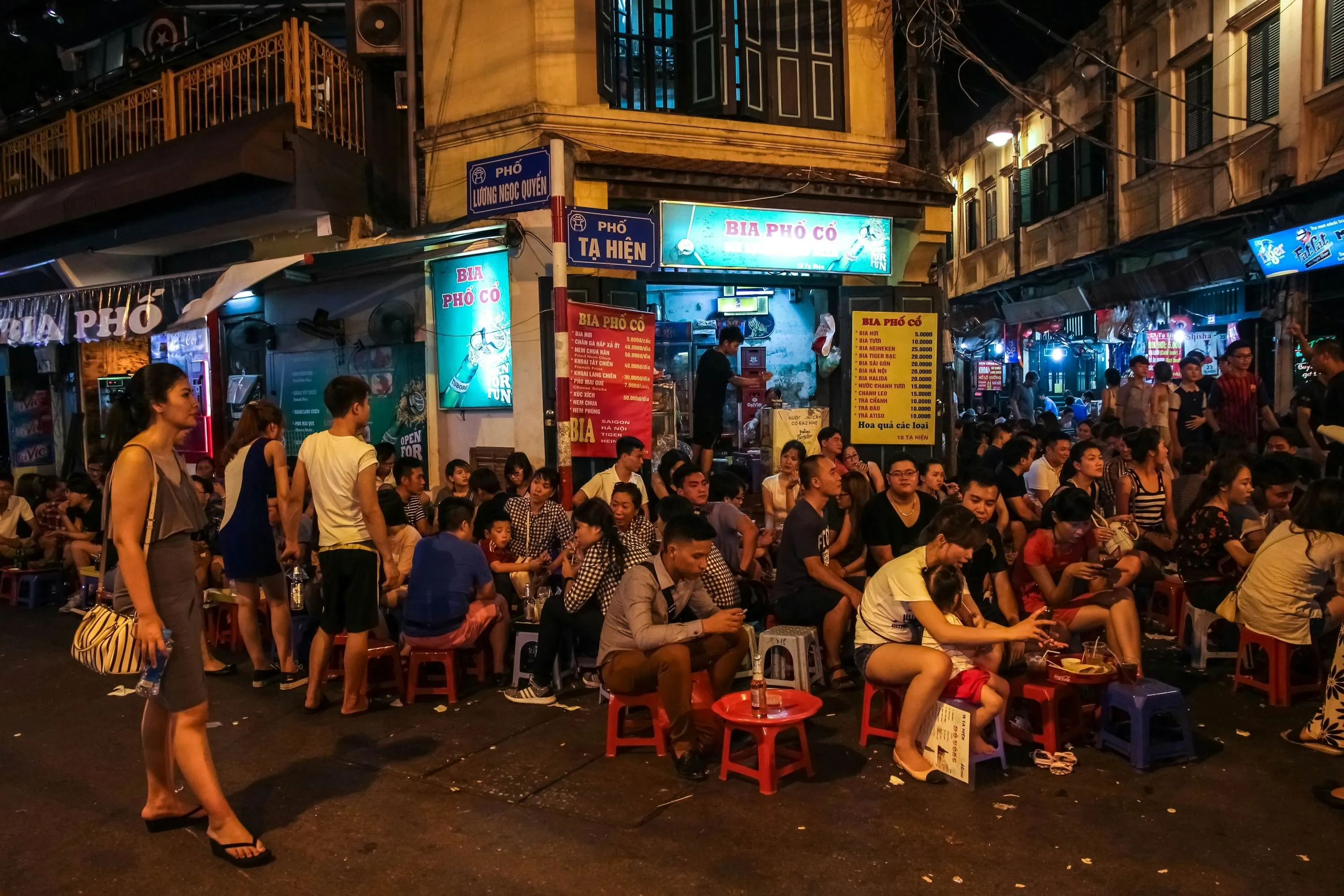 A crowded street corner in the old quarter of the city of Hanoi with young people sitting on stools while enjoying bia hoi (fresh beer).
A crowded street corner in the old quarter of the city of Hanoi with young people sitting on stools while enjoying bia hoi (fresh beer).
Frequently Asked Questions About Seeing Vietnam
What are the absolute must-see places in Vietnam for a first-time visitor?
For a first-time trip focusing on the Best Things To See In Vietnam, consider a classic north-to-south or south-to-north route. This would typically include Hanoi (history, culture, food), Halong Bay (stunning karst landscape), Hue (imperial history, food), Hoi An (charming ancient town, nearby My Son), and Ho Chi Minh City (modern history, vibrant city life, nearby Mekong Delta and Cu Chi tunnels).
Is Vietnam’s cuisine a major reason to visit?
Absolutely! Vietnamese cuisine is celebrated globally for its fresh ingredients, balanced flavors, and regional diversity. Experiencing dishes like pho, bun cha, banh mi, and regional specialties in their birthplace is a huge draw and offers deep insight into the local culture and history through food – truly essential things to see in Vietnam (and taste!).
What historical sites should I prioritize seeing in Vietnam?
Key historical sites among the Best Things To See In Vietnam include the Imperial Citadel and tombs in Hue, the My Son Sanctuary (Cham ruins), the War Remnants Museum and Cu Chi Tunnels near Ho Chi Minh City, and sites within Hanoi like the Temple of Literature or Hoa Lo Prison.
What’s the best way to experience Vietnam’s natural landscapes?
Vietnam offers incredible natural beauty. Don’t miss the karst scenery of Halong Bay or Bai Tu Long Bay, the massive caves of Phong Nha-Ke Bang National Park, the lush waterways of the Mekong Delta, the terraced rice fields and mountains of the northern highlands (perhaps by motorbike), and its diverse coastline with beaches ranging from bustling to secluded. These natural wonders are quintessential things to see in Vietnam.
Plan Your Trip to See Vietnam’s Wonders
Vietnam is a country of incredible diversity, offering experiences that cater to every interest – from history buffs and foodies to adventure seekers and those looking for relaxation. These 15 Best Things To See In Vietnam provide a starting point for planning your own unforgettable journey. Embrace the opportunity to explore its landscapes, delve into its rich history and culture, savor its exquisite cuisine, and connect with its warm and resilient people. Vietnam is ready to reveal its many wonders to you.
